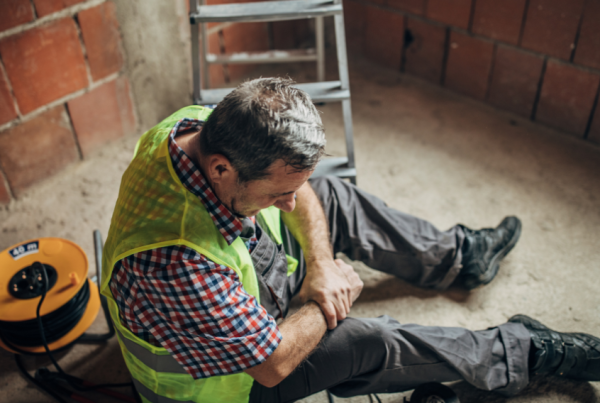Low Back Surgery Recovery
Move Better. Live Fuller. Your Wellness Journey Starts Here.
Schedule a FREE Discovery Call!
About Low Back Surgery
While low back pain may be a common experience for many, in some cases it can be debilitating. Very severe low back problems can prevent individuals from working, performing daily activities, and even enjoying life.
In situations where the pain is extreme, mobility is very limited, or other treatments have failed to provide improvement, low back surgery may be suggested by your provider. Some other symptoms that may suggest a need for surgery can include:
- Difficulty sleeping due to pain
- Difficulty using stairs
- Difficulty rising from a chair

There are a few different types of surgery that may relieve your pain. The surgery chosen by your provider depends on the cause of your pain, which can be from a few different issues with the spine. Your pain may be caused by a variety of conditions or afflictions such as bone overgrowths, degeneration of spinal cushioning, or compression of a nerve. Here are a few different surgeries used to relieve symptoms of low back pain caused by such conditions:
- Spinal fusion: This type of surgery joins two vertebrae together. It utilizes structural implants to stabilize the problematic area, and is common for pain caused from arthritis or degenerative diseases.
- Discectomy: In the case of pain caused by a herniated disk, a discectomy can remove the damaged portions of the disk causing issues. Sometimes this procedure is performed in conjunction with other back surgeries.
- Artificial disc replacement: Similarly to the above procedure, this surgery aims to relieve symptoms by completely replacing a damaged spinal disk.
- Laminectomy: This is a decompression surgery that removes part of the spinal bone in order to release pressure from a nerve or nerve root. This type of surgery is common for lumbar spinal stenosis.
Why Is Physical Therapy Necessary?
Physical therapy will be essential to an effective low back surgery recovery. While you may expect the surgery to magically fix all your back pain problems, it unfortunately doesn’t really work like that. The back muscles and spine are complex structures, and will need careful rehabilitation after your surgery.
Working with a physical therapist before your surgery can be very beneficial, too. Improving the health of your lower back and lower body before surgery can make your recovery process much easier. By building strength and flexibility beforehand, you will be setting yourself up for a less difficult and perhaps even quicker recovery.
Your recovery experience will greatly depend on the type of back surgery you need, as some are more minimally invasive than others. Some types of low back surgeries will have longer healing periods and more symptoms during recovery than others.
Because low back surgeries can vary widely in terms of both the actual process and location of the procedure, it is very important to work closely with your surgeon and physical therapist as you slowly return to activity again. They will be able to help you understand what movements are safe in your unique case, and when to increase your level of activity as your body heals.
Regardless of the type of surgery you will need, engaging in physical therapy afterwards will be absolutely necessary. Physical therapy is usually needed soon after your operation, as remaining immobile for too long can create stiffness and muscle weakness. Your physical therapist will work with you in ways that slowly progress alongside your recovery, so that you can get back to optimal and painless function.
In the next section, we’ll go over some ways a physical therapist can help with your low back surgery recovery!
Physical Therapy for Low Back Surgery
After surgery, your muscles will be weakened and you may find it difficult to move around as normal. While you’ll still be able to walk, you’ll feel stiff and have less mobility, which may prevent you from engaging in normal activities. Getting back to being mobile and practicing movements at home will be a very important start to your recovery. Working with a professional during this time will be essential to preventing complications.
Your physical therapist will create an individualized plan to restore your body’s function, mobility, and flexibility following your operation. Thanks to their expert knowledge and experience, they will know how to progress your care plan at an appropriate pace. Additionally, your physical therapist will be able to help you manage your pain during your recovery.
Pain Management
Managing pain can include a variety of methods to reduce inflammation and swelling of the affected area. Your physical therapist may suggest therapeutic modalities to use at home, or may relieve pain in-office with electric stimulation or manual therapies such as dry needling, tissue scraping, and more. Because each stage of recovery is different, they will only use treatments that are safe and suitable for your stage of healing as you progress through recovery.
Rehabilitation
In addition to pain management, your physical therapist will restore function to your low back by working to improve the strength and range of motion of your muscles. They will create an exercise and stretching plan that will encourage painless mobility and flexibility to your back once again. Part of regaining proper motion includes improving core strength and overall body stability, which will be incorporated into your exercise plan.
Scar Tissue Care
Formation of scar tissue is another normal and expected part of low back surgery that physical therapists can help you manage. Maintaining scar health is very important for preventing pain and dysfunction. Your physical therapist will utilize treatments that will not only reduce the appearance or pain associated with scar tissue, but also prevent the formation of adhesions and other complications.
Exercise Prescription
Practicing at home will be essential to your recovery, especially if you are expected to have a longer recovery period. Your physical therapist will be able to teach you a variety of exercises and stretches to continue at home to improve your mobility and range of motion. These may progressively become more challenging as your body heals.
As you can see from the examples above, physical therapy plays a very important role for low back surgery recovery. It is essential to regaining function and mobility, and can help you prepare ahead of time for a better recovery, too. The physical therapists at Hive Therapy and Wellness are very skilled and experienced in supporting clients who have had back surgery! Some of the treatments you can expect to receive when working with our experts for this type of surgery include:
- Dry needling
- Cupping
- Manual therapy
- Spinal manipulation
- Electrical muscle stimulation
- Tissue scraping
- Exercise prescription
- Behavioral modifications
- Therapeutic modalities
- Neuromuscular re-education
- Biofeedback
- Therapeutic activity
While low back pain may be a common experience for many, in some cases it can be debilitating. Very severe low back problems can prevent individuals from working, performing daily activities, and even enjoying life.
In situations where the pain is extreme, mobility is very limited, or other treatments have failed to provide improvement, low back surgery may be suggested by your provider. Some other symptoms that may suggest a need for surgery can include:
- Difficulty sleeping due to pain
- Difficulty using stairs
- Difficulty rising from a chair
There are a few different types of surgery that may relieve your pain. The surgery chosen by your provider depends on the cause of your pain, which can be from a few different issues with the spine.
Your pain may be caused by a variety of conditions or afflictions such as bone overgrowths, degeneration of spinal cushioning, or compression of a nerve. Here are a few different surgeries used to relieve symptoms of low back pain caused by such conditions:
- Spinal fusion: This type of surgery joins two vertebrae together. It utilizes structural implants to stabilize the problematic area, and is common for pain caused from arthritis or degenerative diseases.
- Discectomy: In the case of pain caused by a herniated disk, a discectomy can remove the damaged portions of the disk causing issues. Sometimes this procedure is performed in conjunction with other back surgeries.
- Artificial disc replacement: Similarly to the above procedure, this surgery aims to relieve symptoms by completely replacing a damaged spinal disk.
- Laminectomy: This is a decompression surgery that removes part of the spinal bone in order to release pressure from a nerve or nerve root. This type of surgery is common for lumbar spinal stenosis.
Physical therapy will be essential to an effective low back surgery recovery.
While you may expect the surgery to magically fix all your back pain problems, it unfortunately doesn’t really work like that. The back muscles and spine are complex structures, and will need careful rehabilitation after your surgery.
Working with a physical therapist before your surgery can be very beneficial, too. Improving the health of your lower back and lower body before surgery can make your recovery process much easier.
By building strength and flexibility beforehand, you will be setting yourself up for a less difficult and perhaps even quicker recovery.
Your recovery experience will greatly depend on the type of back surgery you need, as some are more minimally invasive than others. Some types of low back surgeries will have longer healing periods and more symptoms during recovery than others.
Because low back surgeries can vary widely in terms of both the actual process and location of the procedure, it is very important to work closely with your surgeon and physical therapist as you slowly return to activity again.
They will be able to help you understand what movements are safe in your unique case, and when to increase your level of activity as your body heals.
Regardless of the type of surgery you will need, engaging in physical therapy afterwards will be absolutely necessary. Physical therapy is usually needed soon after your operation, as remaining immobile for too long can create stiffness and muscle weakness.
Your physical therapist will work with you in ways that slowly progress alongside your recovery, so that you can get back to optimal and painless function.
In the next section, we’ll go over some ways a physical therapist can help with your low back surgery recovery!
After surgery, your muscles will be weakened and you may find it difficult to move around as normal. While you’ll still be able to walk, you’ll feel stiff and have less mobility, which may prevent you from engaging in normal activities.
Getting back to being mobile and practicing movements at home will be a very important start to your recovery. Working with a professional during this time will be essential to preventing complications.
Your physical therapist will create an individualized plan to restore your body’s function, mobility, and flexibility following your operation. Thanks to their expert knowledge and experience, they will know how to progress your care plan at an appropriate pace.
Additionally, your physical therapist will be able to help you manage your pain during your recovery.
Pain Management
Managing pain can include a variety of methods to reduce inflammation and swelling of the affected area. Your physical therapist may suggest therapeutic modalities to use at home, or may relieve pain in-office with electric stimulation or manual therapies such as dry needling, tissue scraping, and more.
Because each stage of recovery is different, they will only use treatments that are safe and suitable for your stage of healing as you progress through recovery.
Rehabilitation
In addition to pain management, your physical therapist will restore function to your low back by working to improve the strength and range of motion of your muscles. They will create an exercise and stretching plan that will encourage painless mobility and flexibility to your back once again.
Part of regaining proper motion includes improving core strength and overall body stability, which will be incorporated into your exercise plan.
Scar Tissue Care
Formation of scar tissue is another normal and expected part of low back surgery that physical therapists can help you manage. Maintaining scar health is very important for preventing pain and dysfunction.
Your physical therapist will utilize treatments that will not only reduce the appearance or pain associated with scar tissue, but also prevent the formation of adhesions and other complications.
Exercise Prescription
Practicing at home will be essential to your recovery, especially if you are expected to have a longer recovery period. Your physical therapist will be able to teach you a variety of exercises and stretches to continue at home to improve your mobility and range of motion. These may progressively become more challenging as your body heals.
As you can see from the examples above, physical therapy plays a very important role for low back surgery recovery. It is essential to regaining function and mobility, and can help you prepare ahead of time for a better recovery, too.
The physical therapists at Hive Therapy and Wellness are very skilled and experienced in supporting clients who have had back surgery! Some of the treatments you can expect to receive when working with our experts for this type of surgery include:
- Dry needling
- Cupping
- Manual therapy
- Spinal manipulation
- Electrical muscle stimulation
- Tissue scraping
- Exercise prescription
- Behavioral modifications
- Therapeutic modalities
- Neuromuscular re-education
- Biofeedback
- Therapeutic activity
You can learn more about these treatments on our Treatments Page.





